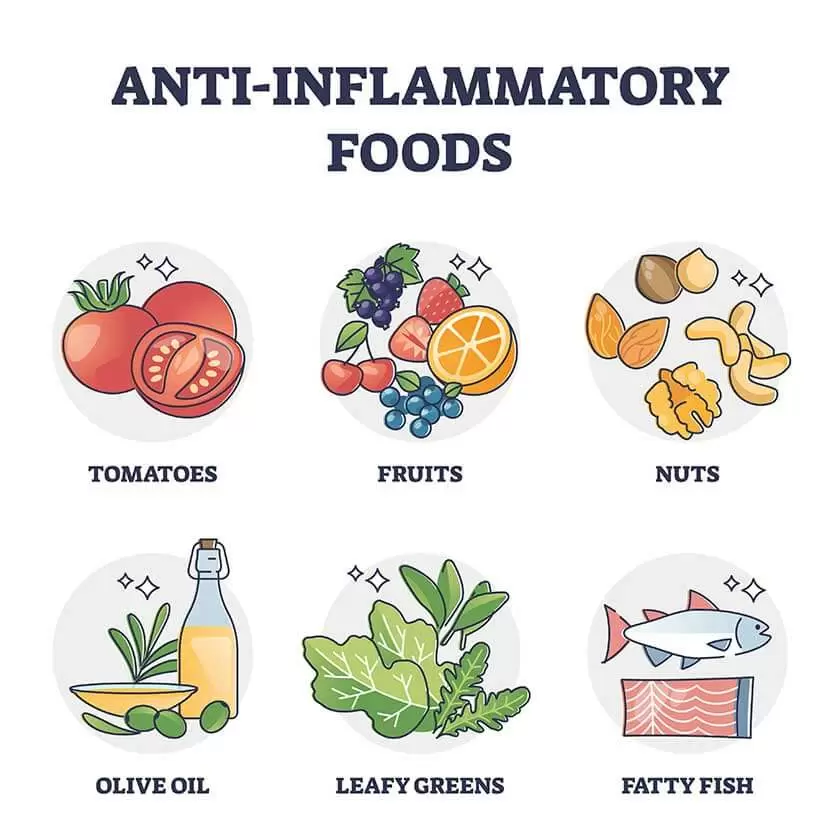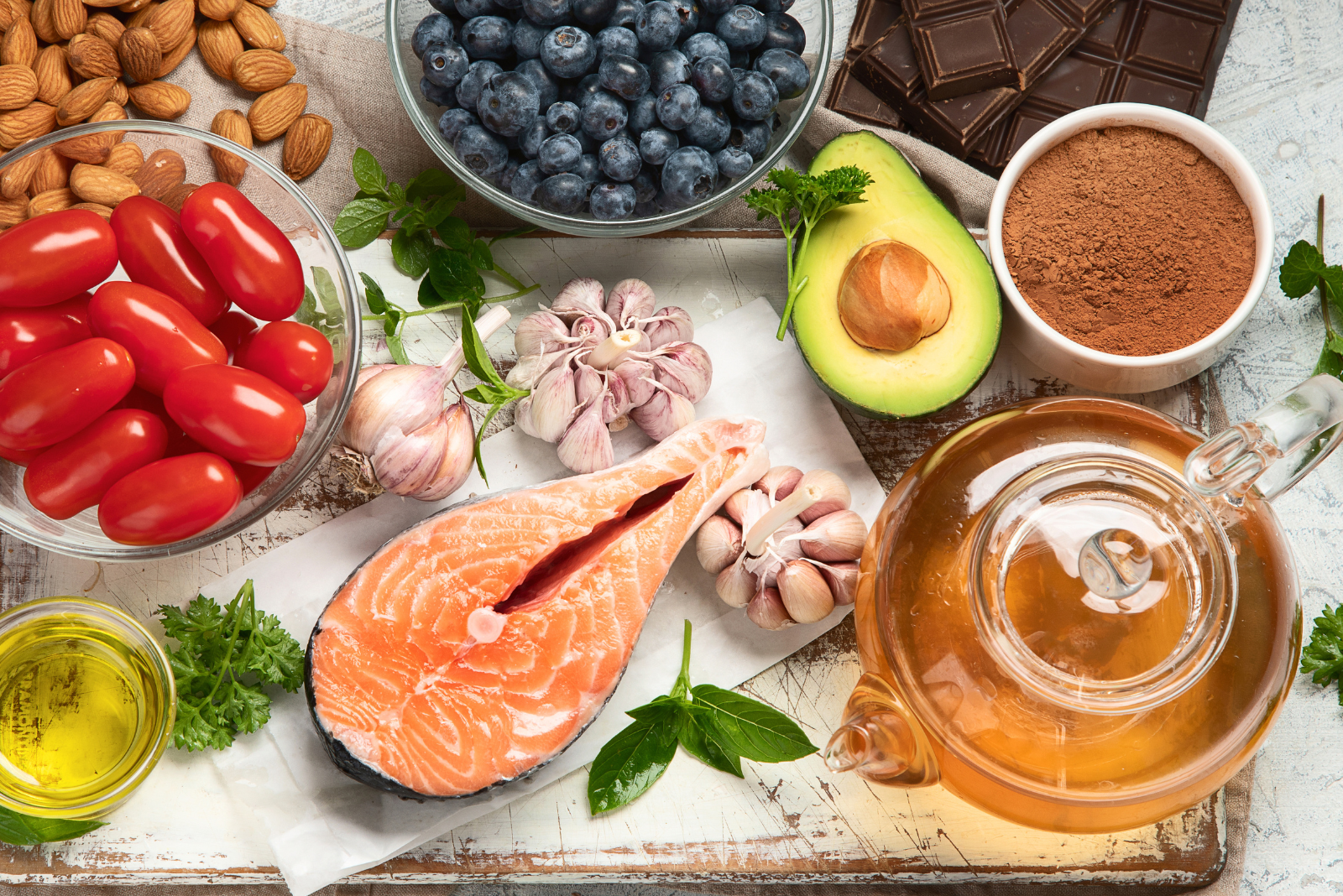
Inflammation is a double-edged sword—vital for healing yet a potential trigger for chronic diseases when driven by poor lifestyle choices, such as diet. The typical Western diet, heavy on processed foods and sugars, is a key perpetrator, setting the stage for a host of health issues.
At Pain Free for Life, we believe in taking control of your health starting with what’s on your plate. As such, we’ve created a simple guide that cuts through the complexity to reveal how practical, informed dietary shifts and lifestyle changes can significantly combat inflammation. It’s not just about avoiding certain foods; it’s about embracing an entire lifestyle that places wellness at the forefront—and don’t worry, we’re helping make these changes simple for you!
Keep reading to learn which foods to favor and which to avoid, and how to embrace a life where food becomes your greatest ally in the drug-free fight against inflammation.
The Western Diet: A Recipe for Chronic Inflammation
Decades of research have uncovered the Western diet’s detrimental role in fanning the fires of body-wide inflammation. Marked by an excess of trans fats, refined carbs, and sugars, this diet is more than an imbalance—it actively disrupts our bodily harmony! The constant influx of pro-inflammatory agents ignites a systemic inflammatory response, turning a temporary protective mechanism into a persistent, harmful state.
Pioneering studies, like one mentioned in this 2020 press release by the Journal of the American College of Cardiology, have shown a direct link between diets rich in inflammatory ingredients and increased levels of inflammatory markers, such as C-reactive protein (CRP), a known indicator of systemic inflammation. Conversely, diets abundant in anti-inflammatory foods—like the Mediterranean diet, renowned for its fruits, vegetables, whole grains, and lean proteins—have been proven to significantly reduce these markers, highlighting the profound impact of diet on inflammation and overall health.
In fact, it’s noteworthy that adopting a Mediterranean diet can lead to a 30% decrease in the risk of major cardiovascular events. This significant finding underscores the diet’s anti-inflammatory and health-promoting benefits.
Anti-Inflammation Foods to Embrace
Omega-3 fatty acids, celebrated for their powerful anti-inflammatory effects, are central to an anti-inflammatory diet. Found abundantly in fatty fish such as salmon, mackerel, and sardines, as well as in plant-based sources like flaxseeds and chia seeds, omega-3s are pivotal in quelling inflammation. Integrating these into your diet not only supports cardiovascular health but also aids in reducing the inflammation associated with chronic conditions.
Equally important is the consumption of colorful fruits and vegetables. These natural treasures are rich in antioxidants and phytonutrients that combat inflammation and protect the body’s tissues from oxidative stress. By embracing a rainbow of plant-based foods, from leafy greens to vibrant berries, you nourish your body with the necessary arsenal to fight inflammation and bolster immune function.
Whole grains and legumes also play a vital role in an anti-inflammatory diet. The fiber found in foods like quinoa, barley, beans, and lentils helps to reduce levels of C-reactive protein, a marker of inflammation in the body. This fiber-rich approach not only aids in digestion but also supports a healthy gut microbiome, further contributing to reduced inflammation and enhanced overall health.
Inflammatory Foods to Avoid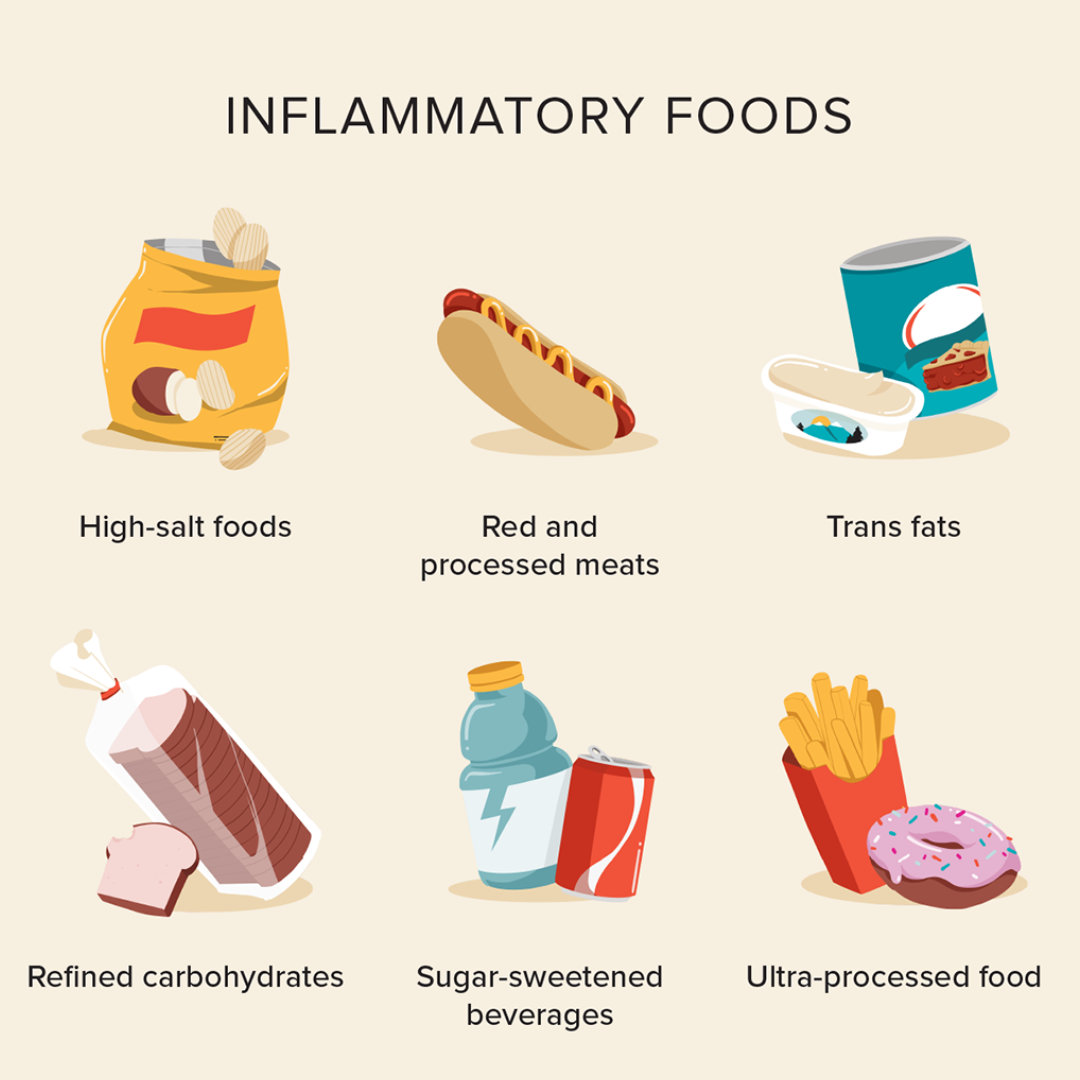
Conversely, certain foods have been shown to exacerbate inflammation and should be limited or avoided. Sugary treats and beverages, for example, can cause spikes in insulin levels and promote inflammatory responses. Similarly, white bread and other refined carbohydrates, with their high glycemic index, can trigger inflammation, underscoring the importance of choosing whole, unprocessed foods.
Processed meats are another category of foods linked to increased inflammation. These items, often high in saturated fats and additives, can contribute to the development of chronic diseases. Opting for leaner protein sources, such as poultry, fish, or plant-based proteins, can help mitigate inflammation and support overall health.
Mastering the Anti-Inflammatory Lifestyle: From Meal Planning, Garden Growing, Smart Shopping Tips & More!
Adopting an anti-inflammatory lifestyle is more than a dietary change; it’s a holistic approach to wellness that integrates mindful eating, strategic meal planning, and even gardening to cultivate a life enriched with health and vitality.
Meal Planning
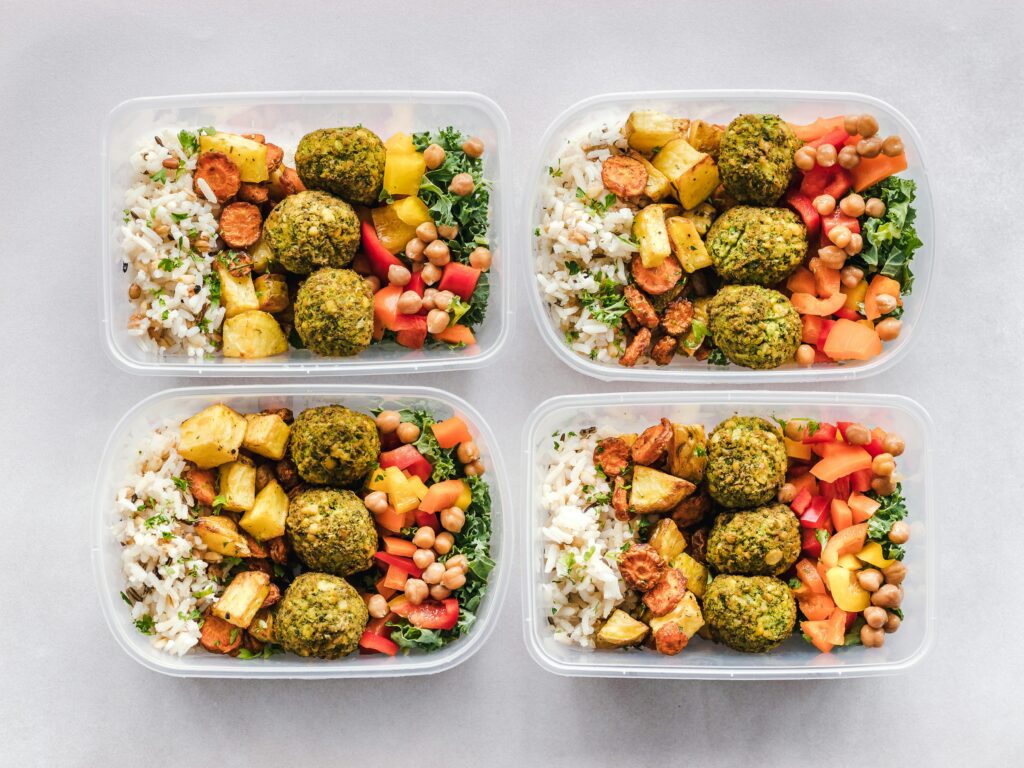
Planning your meals and shopping in advance for them is a foundational step in the transition to an anti-inflammatory lifestyle. Remember, healthy foods like fast food are readily available at the tips of our fingers. We just have to be intentional and PLAN to incorporate healthy food into our lifestyle. So, how do you go about it?
By thoughtfully preparing a weekly menu, you can ensure a balanced intake of anti-inflammatory foods such as leafy greens, colorful fruits, omega-3-rich fish, and whole grains. This approach not only diversifies your palate but also streamlines your grocery shopping, making it easier to stick to your dietary goals (and stay within your food budget). Additionally, preparing meals in advance can help mitigate the temptation of convenient but inflammatory fast-food options, setting you up for success.
Kickstart your anti-inflammatory lifestyle with our exclusive downloadable meal planner! Designed to simplify your meal prep and ensure you’re filling your plate with nourishing, inflammation-fighting foods. Incorporate the recipes we’ve highlighted to effortlessly plan your week.
Pro Tip: Print and laminate your planner for endless reuse with a dry-erase marker.
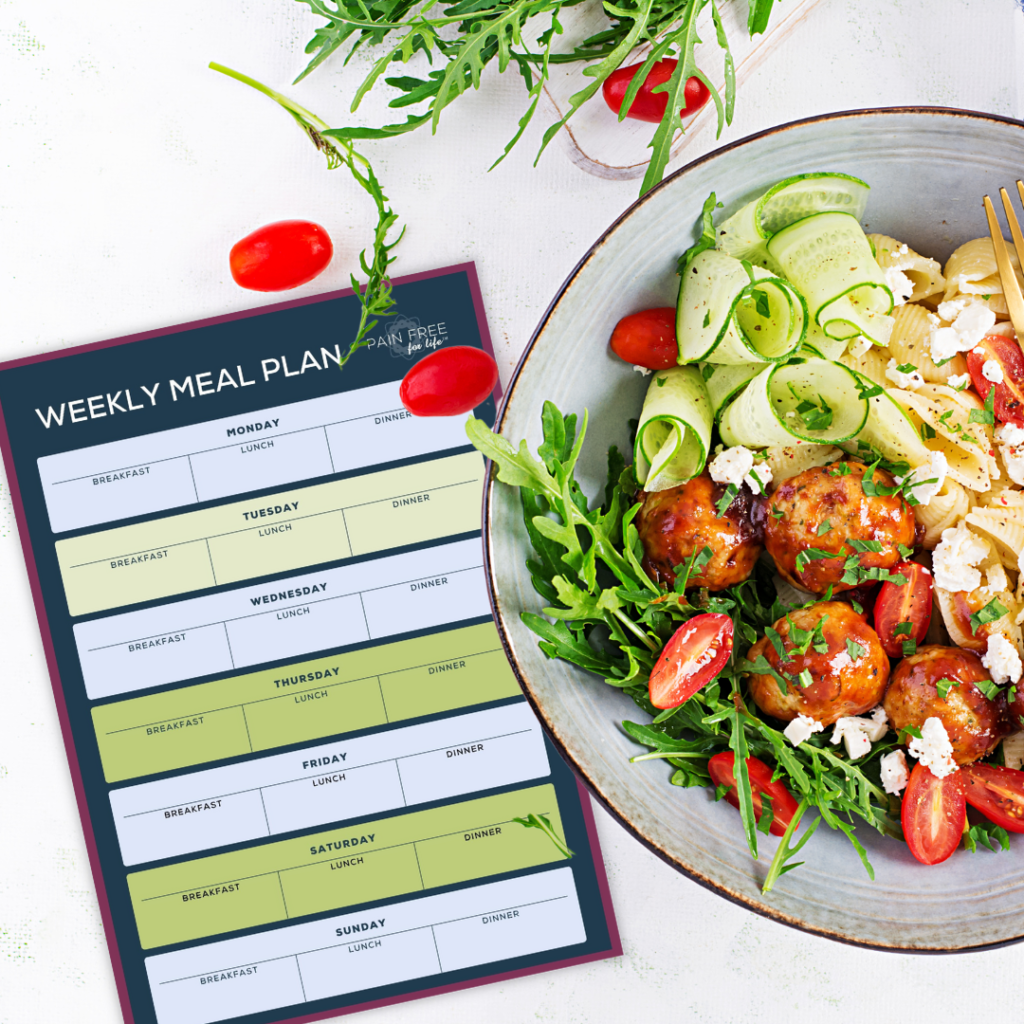
Smart Shopping: Navigating the Grocery Aisles
Smart shopping is pivotal in supporting your anti-inflammatory diet. Start by becoming a savvy label reader, keenly aware of hidden sugars, unhealthy fats, and artificial additives that lurk in packaged foods. Opt for organic produce when possible to minimize exposure to pesticides, and prioritize buying from local farmers’ markets, which offer fresher and more nutrient-dense options. Furthermore, investing in quality proteins and fats, like grass-fed meats and cold-pressed oils, can elevate the anti-inflammatory potential of your meals.
Reducing or eliminating these from your diet can contribute to better overall health and potentially lower the risk of chronic inflammation-related diseases.
| INGREDIENT | COMMONLY FOUND IN | REASON TO AVOID |
|---|---|---|
| Sugar | Sodas, candy, baked goods, many processed foods | High intakes of sugar can lead to increased inflammation and insulin resistance, and can contribute to the development of a variety of health issues. |
| Trans Fats | Fried foods, processed snack foods, margarine | Trans fats are linked to increased inflammation, heart disease, and stroke. They can also lead to increased bad cholesterol levels while lowering good cholesterol. |
| Omega-6 Fatty Acids | Vegetable oils (corn, safflower, soybean, peanut) | While necessary in small amounts, excessive consumption can promote inflammation, especially when the balance with omega-3 fatty acids is off. |
| Refined Carbohydrates | White bread, pastries, pasta, processed snacks | These can spike blood sugar levels, leading to increased insulin production and inflammation. |
| MSG (Monosodium Glutamate) | Processed foods, fast foods, seasonings, soup mixes | MSG can trigger chronic inflammation and adversely affect liver health. |
| Artificial Sweeteners | Diet sodas, sugar-free candies, low-calorie products | Some studies suggest that artificial sweeteners may disrupt the gut microbiome and increase inflammation. |
| Gluten | Wheat-based products, many grains | For individuals with gluten sensitivity or celiac disease, gluten consumption can trigger an inflammatory response. |
| Dairy Products | Milk, cheese, butter | Some individuals may experience inflammation due to lactose intolerance or a sensitivity to the proteins found in dairy. |
| Alcohol | Beer, wine, spirits | Excessive alcohol consumption can lead to a variety of health issues, including chronic inflammation. |
| Preservatives and Colorants | Many processed foods | Certain food additives can trigger inflammatory responses, especially in individuals with sensitivities to these chemicals. |
| Aspartame | Diet sodas, sugar-free products | As an artificial sweetener, aspartame can disrupt metabolic processes and has been linked to an increased risk of inflammation in some individuals. |
| High-Fructose Corn Syrup | Soft drinks, candies, sweetened foods | Similar to sugar, high-fructose corn syrup can promote inflammation, obesity, diabetes, and other health issues. |
Avoiding or limiting these ingredients can help manage inflammation levels and contribute to a healthier lifestyle. Always check labels when shopping and opt for whole, unprocessed foods whenever possible.
Here’s a tip: Next time you shop for groceries, stick to the outer aisles where you’ll find fresh, whole foods like fruits, vegetables, lean meats, and dairy. Avoid the center aisles filled with processed foods that lack nutritional value and may contribute to health issues. This simple strategy promotes healthier choices and supports your well-being.
The Joy of Experimentation in the Kitchen

Transitioning to an anti-inflammatory diet opens the door to a world of culinary exploration, making the journey an exciting adventure filled with new flavors and textures. As you embrace this lifestyle, you’ll find that experimenting in the kitchen not only broadens your culinary skills but also introduces you to a diverse palette that makes healthy eating truly enjoyable.
Incorporating spices and herbs like turmeric and ginger, known for their anti-inflammatory properties, can significantly enhance the taste and therapeutic benefits of your meals. These ingredients not only add a burst of flavor but also bring a host of health benefits to your dishes, making every meal a step toward better health.
Spark your culinary creativity with these free resources:
- Discover fresh, healthy recipes perfect for spring
- Indulge in crispy, crunchy snack recipes that won’t trigger inflammation
- And learn how to enjoy holiday flavors without inflammation.
- Additionally, explore nature’s arsenal against discomfort with natural herbs and supplements that effectively combat chronic pain.
With a little attention, cooking becomes more than just a daily chore. It transforms into a creative outlet that allows you to customize your meals to fit your nutritional needs and personal taste preferences. By exploring these resources, you enrich your diet with anti-inflammatory powerhouses and enjoy cooking as an art form, blending health and pleasure in every bite.
Gardening: Cultivating Your Own Anti-Inflammatory Foods

Gardening is a natural extension of the anti-inflammatory lifestyle, offering a rewarding way to connect with your food source. Growing your own fruits, vegetables, and herbs not only ensures the freshest ingredients for your meals but also provides the satisfaction of tending to and harvesting your produce. Even small spaces can yield abundant crops with container gardening or vertical planters.
For those living in apartments or urban areas without access to land, joining a community garden can be a fantastic solution. Community gardens offer shared spaces where individuals can come together to cultivate plants, share knowledge, and reap the benefits of gardening, even in limited space.
By participating in a community garden, you gain access to a plot of land for gardening and become part of a supportive community of like-minded individuals. You’ll have the opportunity to learn from experienced gardeners, exchange seeds and plants, and collaborate on communal projects. Community gardens also often provide resources, such as tools, water sources, and composting facilities, making it easier for apartment dwellers to engage in gardening without requiring extensive equipment or space.
Whether you’re growing herbs on your windowsill or tending to a plot in a community garden, gardening offers a fulfilling way to embrace the anti-inflammatory lifestyle and reconnect with the natural world. So, if you want to incorporate more fresh, homegrown ingredients into your diet and enhance your well-being, consider joining a community garden and reaping the rewards of gardening today!
From the simplicity of fresh basil to the vibrancy of homegrown tomatoes, a garden brings the anti-inflammatory diet to your doorstep, encouraging a deeper appreciation for nature’s bounty.
- Discover creative ways to use your garden’s bounty, such as with these zucchini recipes and pumpkin recipes, which are designed to boost health and eliminate pain.
Incorporating Movement and Mindfulness

An anti-inflammatory lifestyle goes beyond diet, embracing physical activity and mindfulness as integral components. Regular exercise, whether it’s yoga, walking, or strength training, complements your dietary efforts by reducing stress and strengthening the body. Mindfulness practices, such as meditation or deep-breathing exercises, can further diminish inflammatory responses by promoting relaxation and emotional balance. Understanding the mind-body connection is crucial in managing pain and maintaining mental health, while also acknowledging the link between mental health and inflammation can provide deeper insights into how emotional well-being impacts physical health.
4 Additional Tips for Switching to an Anti-Inflammatory Diet
Switching to an anti-inflammatory diet is a transformative journey that goes beyond merely eliminating certain foods—it’s about embracing a way of eating that heals and nourishes. This path isn’t about restriction; it’s a holistic approach that emphasizes incorporating foods known to reduce inflammation and boost overall health.
Here are four additional tips to ease your transition:
- Simplify Food Preparation: Discovering simple yet effective food prep strategies can make adopting a low-inflammation diet seamless and enjoyable. Embrace meal planning and batch cooking to ensure you always have healthy, anti-inflammatory options at hand.
- Understand Inflammation: Gaining a comprehensive understanding of inflammation—its causes, symptoms, and how to counteract it—is crucial. This knowledge empowers you to make informed choices about your health and directly address inflammation’s root causes.
- Make Informed Food Choices: Educate yourself on the foods that trigger inflammation and those that combat it. Knowing what to eat and what to avoid is key to successfully managing inflammation through diet.
- Leverage Expert Protocols: Utilizing structured approaches like The Hache Protocol can significantly enhance your efforts to fight inflammation. Such protocols offer tailored advice and strategies, helping you navigate your dietary changes with confidence. For those ready for a deeper commitment, The Hache Protocol Reset offers a comprehensive guide to resetting your health.
Inflammation isn’t an unavoidable consequence of aging or lifestyle. With thoughtful dietary changes and a commitment to holistic well-being, you can greatly reduce inflammation’s impact on inflammaging and more. Each meal is an opportunity to fortify your health, shielding your body from the inside out. Start on this path today, and step into a future that is vibrant with health and free from the confines of pain.





